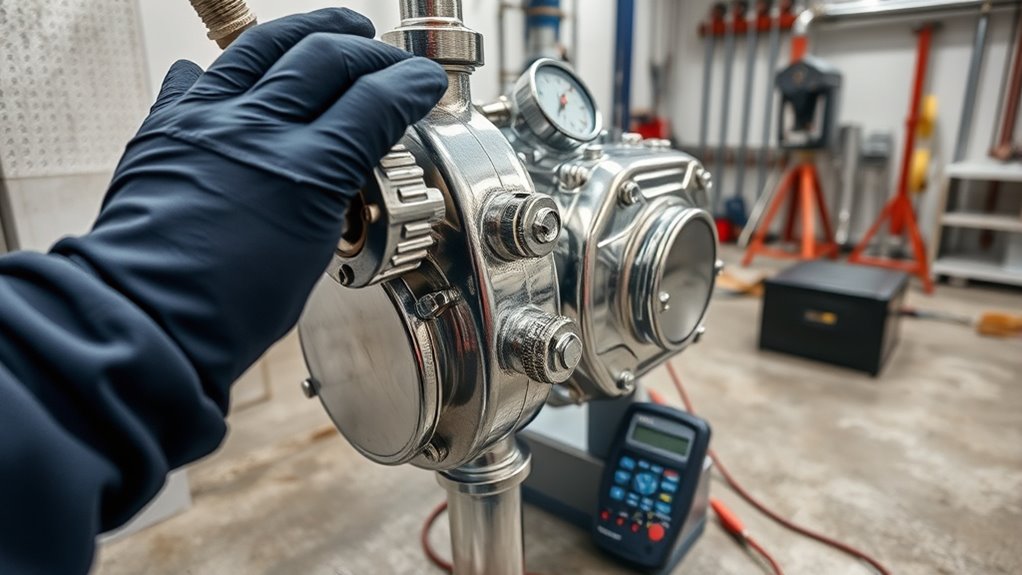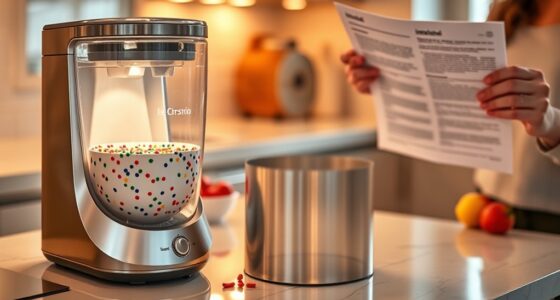To keep your booster pump running smoothly, regularly inspect for signs of malfunction like unusual noises, leaks, or pressure drops. Make certain the seal is properly lubricated with high-quality grease to prevent wear and leaks. Check for debris or contamination, tighten fittings if needed, and monitor pressure and flow rates. Routine maintenance extends your pump’s lifespan and keeps it performing at its best. If you want to learn more about keeping your pump in top shape, follow the next steps.
Key Takeaways
- Regularly inspect the pump for unusual noises, leaks, or pressure drops indicating potential issues.
- Lubricate seals and moving parts with high-quality, compatible grease to prevent wear and leaks.
- Check and tighten fittings, seals, and connections to avoid leaks and maintain proper pressure.
- Clean or replace filters periodically to prevent debris buildup that can cause overworking or damage.
- Schedule routine maintenance to extend pump lifespan, optimize performance, and prevent costly failures.

Regular maintenance is vital to keep your booster pump running efficiently and prevent costly breakdowns. One of the most common issues you might notice is unusual pump noise. If your pump suddenly becomes louder or starts making grinding or squealing sounds, it’s a sign that something’s off. Often, excessive noise indicates that the pump’s internal components are under strain, possibly due to worn-out bearings or insufficient lubrication. Addressing these issues early can save you from more serious damage down the line. Regularly inspecting the pump and listening for abnormal sounds should be part of your routine. If you notice increased noise, it’s a good idea to check the pump’s seal and lubrication points. Proper maintenance practices can extend the lifespan of your equipment and ensure optimal performance.
Seal lubrication plays a vital role in maintaining your booster pump’s performance. The seal prevents water or other fluids from leaking out and keeps debris from entering the system. Over time, the seal can dry out or become contaminated, leading to leaks and reduced efficiency. When this happens, you might notice a decrease in water pressure or an increase in pump noise. To avoid these problems, it’s important to regularly lubricate the seal according to the manufacturer’s recommendations. Use the proper lubricant—usually a high-quality, compatible grease—to ensure the seal remains flexible and effective. Proper seal lubrication not only prevents leaks but also reduces wear and tear on the pump’s moving parts, extending its lifespan. Additionally, maintaining proper lubrication can help prevent corrosion and rust formation inside the pump, which are common causes of mechanical failure. In addition to lubricating the seal, you should keep the entire pump well-maintained by checking for leaks, tightening fittings, and ensuring that all moving parts are properly aligned. Regularly inspecting the pump’s pressure and flow rates can also help you catch issues early. If you notice a drop in performance or an increase in noise, it’s a sign that maintenance might be overdue. Don’t forget to clean or replace filters as needed, as clogged filters can cause the pump to work harder than necessary, leading to increased noise and wear. Keeping the pump clean and well-lubricated minimizes the risk of overheating and mechanical failure.
Frequently Asked Questions
How Often Should I Schedule Professional Inspections for My Booster Pump?
You should schedule professional inspections for your booster pump at least once a year. During these routine checks, a professional can identify early signs of wear, perform necessary part replacements, and make certain everything functions smoothly. Regular inspections help prevent unexpected breakdowns, extend the pump’s lifespan, and keep your system operating efficiently. Don’t wait for issues to arise—regular maintenance is key to reliable performance and peace of mind.
Can I Upgrade My Booster Pump for Higher Efficiency?
Sure, upgrading your booster pump for higher efficiency sounds like a brilliant idea—until you realize pump maintenance becomes even trickier. Yes, efficiency upgrades can boost performance, but they often require careful planning and professional help. Before diving in, weigh the costs and benefits, and guarantee your system is compatible. After all, a more efficient pump is only as good as the maintenance behind it.
What Are Common Signs of Booster Pump Failure?
You might notice signs of booster pump failure if it starts making unusual pump noise or exhibits vibration issues. These symptoms often indicate worn-out bearings, misalignment, or other mechanical problems. If the pump noise becomes louder or vibrations increase, it’s a clear sign to inspect and service your pump promptly. Addressing these issues early can prevent further damage and guarantee your booster pump continues running efficiently.
How Do Temperature Fluctuations Affect Booster Pump Performance?
Think of your booster pump as a delicate dancer, sensitive to temperature stress. When temperatures fluctuate, thermal expansion occurs, causing components to expand or contract. This can lead to misalignments, leaks, or reduced efficiency. You might notice increased noise or pressure drops. To prevent performance issues, keep the pump in a stable environment and monitor temperature changes regularly, ensuring thermal expansion doesn’t compromise its smooth operation.
Is It Necessary to Drain and Flush the Pump Regularly?
You should regularly drain and flush your booster pump to keep it in ideal condition. This helps with pump lubrication by removing debris that can cause friction and wear. It also aids in corrosion prevention by flushing out minerals and contaminants that could lead to rust. Routine maintenance ensures your pump operates efficiently and prolongs its lifespan, saving you time and money in the long run.
Conclusion
Keep your booster pump in top shape by following regular maintenance checks. For example, imagine a small business relying on their pump to ensure steady water pressure; neglect leads to unexpected failures and costly repairs. By staying proactive—cleaning filters, checking for leaks, and scheduling inspections—you prevent downtime and extend your pump’s lifespan. Stay vigilant, and your booster pump will continue to serve you reliably, saving you time and money in the long run.









